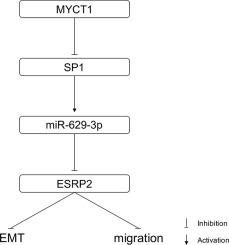Cellular Signalling ( IF 4.4 ) Pub Date : 2020-07-11 , DOI: 10.1016/j.cellsig.2020.109709 Peng-Jie Yue 1 , Yuan-Yuan Sun 1 , Yun-Hui Li 2 , Zhen-Ming Xu 3 , Wei-Neng Fu 1

|
MYCT1 has an inhibitory effect on the migration of laryngeal cancer cells, although the underlying molecular mechanism remains unknown. In this study, we aimed to explore the mechanism of MYCT1 in the epithelial-mesenchymal transition (EMT) and migration of laryngeal cancer cells. We found that MYCT1 significantly decreased the expression of miR-629-3p but increased the expression of ESRP2 in laryngeal cancer cells. The expression of miR-629-3p and ESRP2 in laryngeal cancer tissues showed significantly positive and negative correlations with patient metastasis, respectively. miR-629-3p was confirmed to repress the expression of ESRP2 by targeting its 3’UTR. SP1 was verified to be a direct transcription factor for miR-629-3p and a downstream target of MYCT1. Moreover, MYCT1 inhibited the EMT and migration of laryngeal cancer cells through the SP1/miR-629-3p/ESRP2 pathway. Taken together, our results establish a novel MYCT1 signaling pathway in the EMT and migration of laryngeal cancer cells, thus providing important insights for further studying the pathway in the diagnosis and treatment of laryngeal cancer.
中文翻译:

MYCT1 通过 SP1/miR-629-3p/ESRP2 通路抑制喉癌细胞的 EMT 和迁移。
MYCT1对喉癌细胞的迁移具有抑制作用,但其潜在的分子机制仍不清楚。在本研究中,我们旨在探讨MYCT1在喉癌细胞上皮间质转化(EMT)和迁移中的作用机制。我们发现MYCT1显着降低喉癌细胞中miR-629-3p的表达,但增加ESRP2的表达。喉癌组织中miR-629-3p和ESRP2的表达量分别与患者转移呈显着正相关和负相关。 miR-629-3p 被证实可通过靶向 ESRP2 的 3'UTR 来抑制 ESRP2 的表达。 SP1 被证实是 miR-629-3p 的直接转录因子和 MYCT1 的下游靶标。此外,MYCT1通过SP1/miR-629-3p/ESRP2通路抑制喉癌细胞的EMT和迁移。综上所述,我们的研究结果在喉癌细胞的EMT和迁移中建立了一条新的MYCT1信号通路,从而为进一步研究该通路在喉癌的诊断和治疗中提供了重要的见解。










































 京公网安备 11010802027423号
京公网安备 11010802027423号